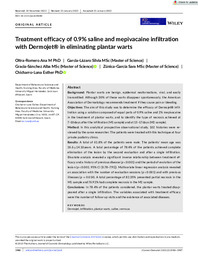Por favor, use este identificador para citar o enlazar este ítem:
https://hdl.handle.net/11000/35011Registro completo de metadatos
| Campo DC | Valor | Lengua/Idioma |
|---|---|---|
| dc.contributor.author | Gracia Sánchez, Alba | - |
| dc.contributor.author | Oltra Romero, Ana María | - |
| dc.contributor.author | Garcia-Lázaro, Silvia | - |
| dc.contributor.author | Zúnica García, Sara | - |
| dc.contributor.author | Chicharro Luna, Esther | - |
| dc.contributor.other | Departamentos de la UMH::Ciencias del Comportamiento y salud | es_ES |
| dc.date.accessioned | 2025-01-20T10:14:59Z | - |
| dc.date.available | 2025-01-20T10:14:59Z | - |
| dc.date.created | 2023 | - |
| dc.identifier.citation | Journal of Cosmetic Dermatology | es_ES |
| dc.identifier.issn | 1473-2165 | - |
| dc.identifier.issn | 1473-2130 | - |
| dc.identifier.uri | https://hdl.handle.net/11000/35011 | - |
| dc.description.abstract | Background Plantar warts are benign, epidermal neoformations, viral, and easily transmitted. Although 30% of these warts disappear spontaneously, the American Association of Dermatology recommends treatment if they cause pain or bleeding. Objectives The aim of this study was to determine the efficacy of Dermojet® infiltration using a solution composed of equal parts of 0.9% saline and 2% mepivacaine in the treatment of plantar warts, and to identify the type of necrosis achieved at 7–10 days after the infiltration (M1 sample) and at 15–17 days (M2 sample). Method In this analytical prospective observational study, 102 histories were reviewed by the same researcher. The patients were treated with this technique at four private podiatry clinics. Results A total of 61.8% of the patients were male. The patients' mean age was 26.6 ± 14.10 years. A total percentage of 78.4% of the patients achieved complete elimination of the lesion by the second evaluation and after a single infiltration. Bivariate analysis revealed a significant inverse relationship between treatment efficacy and a history of previous disease (p < 0.001) and the period of evolution of the lesion (p < 0.001; 95% CI [0.78–7.91]). Multivariate linear regression analysis revealed an association with the number of evaluation sessions (p < 0.001) and with previous illnesses (p = 0.014). A total percentage of 82.35% presented partial necrosis in the M1 sample and 76.92% had complete necrosis in the M2 sample. Conclusions In 78.4% of the patients considered, the plantar warts treated disappeared after a single infiltration. The variables associated with treatment efficacy were the number of follow-up visits and the existence of associated diseases. | es_ES |
| dc.format | application/pdf | es_ES |
| dc.format.extent | 8 | es_ES |
| dc.language.iso | eng | es_ES |
| dc.publisher | Wiley | es_ES |
| dc.relation.ispartofseries | 22 | es_ES |
| dc.relation.ispartofseries | 7 | es_ES |
| dc.rights | info:eu-repo/semantics/openAccess | es_ES |
| dc.rights | Attribution-NonCommercial-NoDerivatives 4.0 Internacional | * |
| dc.rights.uri | http://creativecommons.org/licenses/by-nc-nd/4.0/ | * |
| dc.subject | Dermojet | es_ES |
| dc.subject | Infiltration | es_ES |
| dc.subject | Plantar warts | es_ES |
| dc.subject | Saline | es_ES |
| dc.subject | Verrucas | es_ES |
| dc.subject.other | CDU::6 - Ciencias aplicadas::61 - Medicina | es_ES |
| dc.title | Treatment efficacy of 0.9% saline and mepivacaine infiltration with Dermojet® in eliminating plantar warts | es_ES |
| dc.type | info:eu-repo/semantics/article | es_ES |
| dc.relation.publisherversion | https://doi.org/10.1111/jocd.15680 | es_ES |

Ver/Abrir:
J of Cosmetic Dermatology - 2023 - Ana M - Treatment efficacy of 0 9 saline and mepivacaine infiltration with Dermojet in.pdf
2,8 MB
Adobe PDF
Compartir:
 La licencia se describe como: Atribución-NonComercial-NoDerivada 4.0 Internacional.
La licencia se describe como: Atribución-NonComercial-NoDerivada 4.0 Internacional.
.png)